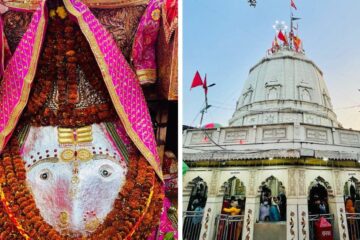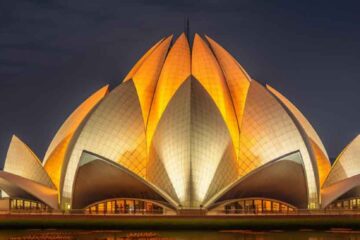Jantar Mantar

Jantar Mantar is an equatorial sundial and astronomical observatory built in the 18th century and located in the center of Delhi. A visit to this place will help you learn about ancient astronomy and understand how humans in the past used to calculate time, find the positions of celestial bodies, and track their movements. When you decide to book a hotel in Delhi for your holidays, make sure this historical site is on your agenda.
Would you like to know more about this nearly three-century-old building? Everything you need to know about Delhi’s Jantar Mantar is covered in this blog, including its background, opening and closing timings, entry cost, and other fascinating information.
Jantar Mantar, New Delhi, Information:
| Location | Connaught Place |
| Timings | 6:00 am to 6:00 pm |
| Entry Fee | ₹ 15 for Indians; ₹ 200 for foreigners |
| Still Camera | Free |
| Video Camera | ₹ 25 |
| Nearest Metro Station | Patel Chowk |
| Type | Astronomical Observatory |
| Year of Establishment | 1724 |
| Founded by | Maharaja Jai Singh II |
| Key Attractions | 13 Astronomical Instruments |
Jantar Mantar: History
Maharaja Jai Singh II of Jaipur built Jantar Mantar in Delhi in 1724. In fact, the Delhi Observatory was the first of the five observatories that the Emperor built during his reign in the early eighteenth century. The locations of the remaining four observatories are Mathura, Varanasi, Ujjain, and Jaipur.
The compilation of astronomical tables and accurate prediction of planetary, moon, and sun movements was the primary goal of the observatory’s construction. It was the first observatory of its kind to be built in India at that time. However, Delhi’s Jantar Mantar began to deteriorate significantly by 1867. Over the years, the Government of India has initiated several projects to renovate the heritage observatory and market it as a Delhi tourist attraction.
Jantar Mantar Architecture
Many astronomical structures and instruments, made entirely of stone, are housed within the huge observatory. These instruments were constructed from rubble, brick, and limestone before plaster was used. The fact that Jantar Mantar is an outdoor observatory in Delhi is another distinguishing aspect. Every piece of equipment on this site is placed outside rather than inside structures such as rooms or buildings.
Although the buildings and equipment have stood the test of time, they still require some maintenance and restoration over time. But at present, there has been no significant change in these buildings inside Jantar Mantar, Delhi.
Structures inside the Jantar Mantar Complex
The four main instruments are among the thirteen astronomy instruments at the Jantar Mantar Observatory in Delhi. These are Samrat Yantra, Jaiprakash Yantra, Ram Yantra, and Mishra Yantra. Maharaja Jai Singh II was the person who designed most of these devices. Below is an explanation of each:
- Samrat Yantra
Known by another name, the Supreme Instrument, it is the principal building within the observatory. The dimensions of this construction are 10 feet thick, 114 feet long at the base, and 70 feet high. It is a huge sundial in the shape of a triangle with a hypotenuse of 128 feet. This hypotenuse is oriented towards the North Pole and lies parallel to the Earth’s axis. On each side of the triangle is a quadrant representing hours, minutes, and seconds.
- Jayaprakash Yantra
The device is made of markings on the concave sides of structures that resemble hollow hemispheres. According to Jaiprakash Yantra, the sun and stars were located in the sky.
- Rama Yantra
There are two large cylindrical structures with open tops on this instrument. Based on Earth’s latitude and longitude, these structures help estimate the altitude of stars.
- Misra Yantra
Its purpose is to determine the longest and shortest days of the year using five different instruments. The names of these instruments are Dakshinottara Bhitthi, Samrat, Niyat Chakra, Karak Rasivaalaya, and Western Quadrantha. The exact meridian can also be determined using the Mishra Yantra. The only instrument at Jantar Mantar that is believed not to have been made by Maharaja Jai Singh II.
Jantar Mantar: Today
Despite the abundance of contemporary observatories across the country, this historic building remains significant. Needless to say, Jantar Mantar is still one of the best sites to visit in Delhi, especially for those who enjoy science, history, and education. Now, the position and time of celestial bodies cannot be determined using observatories. Still, it stands as a testament to humanity’s perseverance and desire to solve the puzzles of the universe.
Lesser-known facts about Jantar Mantar
- The sundial was already in use when this observatory was built. However, this observatory’s Emperor instrument transformed the ordinary sundial into a precise instrument for detecting many aspects of celestial bodies, such as the inclination angles of the planets.
- The symbols of the 1982 Asian Games, which were held in New Delhi, also included Jantar Mantar.
- The observatory’s instruments have been thoughtfully designed and arranged so that visitors can use only their eyes to see the positions of celestial bodies.
- About seven years were spent running the observatory, collecting, compiling, and transmitting the data to the reigning king. However, when tall structures were built around the structure, it stopped providing reliable data.
- The terms mantra, which means to calculate, and jantra, or yantra, which means instrument, are the source of the name Jantar Mantar. Thus, both terms collectively translate to “calculation instrument.”
Attractions near Jantar Mantar, Delhi
- Bangla Sahib Gurudwara (700 m)
- National Museum (2.3 km)
- Birla Temple (2.6 km)
- Parliament House (2.7 km)
- Rashtrapati Bhavan (2.8 km)
- Agrasen ki Baoli (3.6 km)
- Gandhi Smriti (4.1 km)
- Khooni Darwaza (4.4 km)
- Delhi Zoo (5 km)
- Humayun’s Tomb (6.6 km)
Visiting this ancient observatory, which earlier helped even the kings and emperors know about the stars and planets in the sky, sounds like a lot of fun. This building bears witness to India’s important scientific advances from centuries ago. Additionally, while you are in the country’s capital, don’t forget to visit other historical sites in Delhi that tell you about its rich past.



4 Comments
India Gate Delhi: History, Architecture, Timings, Entry Fee · February 22, 2024 at 1:39 pm
[…] Jantar Mantar (2.9 km) […]
Purana Qila, Delhi: History, Architecture, Timings, and Entry Fee · February 22, 2024 at 2:59 pm
[…] Jantar Mantar (5 km) […]
Raj Ghat, Delhi: Information, History, Timings, Entry Fee · February 22, 2024 at 3:00 pm
[…] JANTAR MANTAR (4.4 km) […]
Gurudwara Bangla Sahib, Delhi: Details, Hours, Place · May 26, 2024 at 5:27 pm
[…] Jantar Mantar is 1.1 kilometres away.Connaught Place Distance: 1.1 kilometresTemple Birla (1.4 km)Bhavan Rashtrapati (2.3 km)Natural History Museum National (2.4 km)3.5 kilometres to Agrasen ki BaoliSmriti Gandhi (4 kilometres)Qila Purana (4.4 km)Jama Masjid (4.5 km)India Gate at 4.7 kmGardens of Lodhi (4.9 km)Delhi Zoo, also known as the National Zoological Park, is five kilometres away. […]